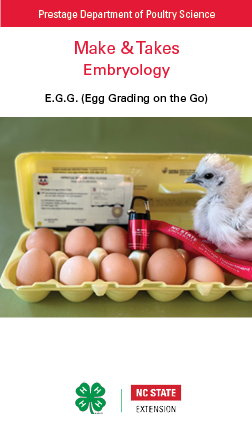Embryology – E.G.G. (Egg Grading on the Go) Activity
go.ncsu.edu/readext?843695
en Español / em Português
El inglés es el idioma de control de esta página. En la medida en que haya algún conflicto entre la traducción al inglés y la traducción, el inglés prevalece.
Al hacer clic en el enlace de traducción se activa un servicio de traducción gratuito para convertir la página al español. Al igual que con cualquier traducción por Internet, la conversión no es sensible al contexto y puede que no traduzca el texto en su significado original. NC State Extension no garantiza la exactitud del texto traducido. Por favor, tenga en cuenta que algunas aplicaciones y/o servicios pueden no funcionar como se espera cuando se traducen.
Português
Inglês é o idioma de controle desta página. Na medida que haja algum conflito entre o texto original em Inglês e a tradução, o Inglês prevalece.
Ao clicar no link de tradução, um serviço gratuito de tradução será ativado para converter a página para o Português. Como em qualquer tradução pela internet, a conversão não é sensivel ao contexto e pode não ocorrer a tradução para o significado orginal. O serviço de Extensão da Carolina do Norte (NC State Extension) não garante a exatidão do texto traduzido. Por favor, observe que algumas funções ou serviços podem não funcionar como esperado após a tradução.
English
English is the controlling language of this page. To the extent there is any conflict between the English text and the translation, English controls.
Clicking on the translation link activates a free translation service to convert the page to Spanish. As with any Internet translation, the conversion is not context-sensitive and may not translate the text to its original meaning. NC State Extension does not guarantee the accuracy of the translated text. Please note that some applications and/or services may not function as expected when translated.
Collapse ▲Egg shells are semipermeable, this means only certain size particles can pass through its pores.
How many pores does an average egg have?
As eggs age, gases and moisture are lost through the pores. Let’s ‘Candle’ the egg (illuminate the interior with light) to find out how these losses change the air cell inside the egg!
Question: How do you ‘peek’ inside an egg to determine its freshness?
Hypothesis: Candling eggs reveals air cell size that: increases or decreases as eggs age.
Materials:
• E.G.G. Kit*, Small LED Flashlight, USDA Official Egg Air Cell Guage, Lanyard
*No Kit – use small LED flashlight or cellphone & find dime, nickel & quarter
• Eggs – try to obtain eggs of various ages for this demonstration (white eggs
are easier to candle)
• Dark or interior room with little natural light
Method:
1. Hold your egg with large end up – this is the ‘Candling End’
2. Shine light on top of this large end
3. The circular area at the top of the egg is the Air Cell
4. Now let’s grade this egg! Look at the concave cutouts at the bottom of your
Air Cell Gauge card and hold them on the large end of your egg (you may
need assistance to hold gauge card and flashlight) Smaller air cells indicate
fresher eggs.
Discussion Questions
1. Students with Good Grades have what letter grades? How about Eggs with good grades? Is an egg with an AA or B Grade better?
2. Without an Air Cell Gauge card, the size of a dime, nickel, and quarter is a way to estimate the size of an egg’s air cell. Do you think an Egg with an air cell the size of a dime or quarter is better?
3. If you are selecting good eggs for hatching, how is it similar to picking fresh eggs for food consumption?
Learn more or how to order an E.G.G. Learning Kit:
go.ncsu.edu/Embryology-E.G.G.



